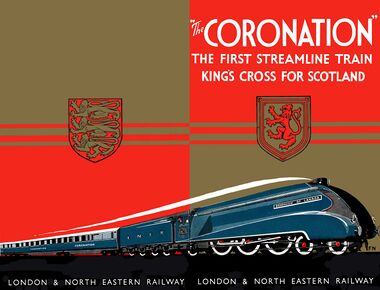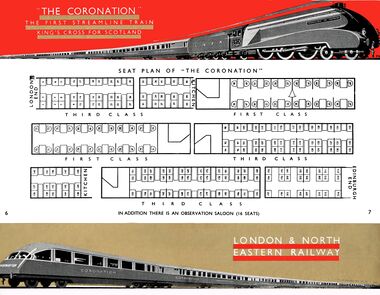Category:The Coronation (train)
1937: "The Coronation, The First Streamline Train", LNER booklet [image info]
1937: Carriage layout for The Coronation [image info]
The Coronation was a streamlined train hauled by streamlined A4 locomotives on the LNER network from 1937. The train was named for the Coronation of King George VI, on 12th May 1937. George had become king in December 1936 with the abdication of Edward VIII, who had been next in line to the throne after the death of George V in January 1936.
The first streamlined A4-hauled train had been the 1935 Silver Jubilee, which had been named after Silver Jubilee of George V, who had then, promptly and rather inconveniently, died, leaving the LNER with a set of pretty silver-and-grey trains commemorating the longevity of a monarch who was actually dead. Trying again with The Coronation, the LNER changed the locomotive colour to garter blue, a colour associated with 4468 Mallard when she broke the official speed record in 1938.
1937 promotional text:
"The Coronation" trains each consist of nine carriages, the last being a fully-streamlined observation saloon fitted with large windows and comfortable armchairs.
The exteriors are distinctive. Painted in Marlborough blue above the waist and Garter blue below, they have mouldings and fittings of stainless steel. Great care has been taken to reduce the wind resistance as much as possible by making the sides of the carriages perfectly smooth and by streamlining the rear end of the tail car. The spaces between the carriages are covered by indiarubber sheeting of the same colours as the body sides.
Something quite new in railway coach design is the division of the interior of each train into sections. Each passenger has the privacy usually associated with a compartment while enjoying the advantages and spaciousness of a saloon.
In the first-class carriages the sections each accommodate four passengers, two at each table arranged on either side of a central gangway. Ornamental screen wings projecting from the partitions give the effect of alcoves for two people. Two swivelling chairs are placed at specially shaped tables, and are so arranged that passengers when dining are facing diagonally towards the windows.
In the third-class part of the train each section seats twelve passengers.
In both the first- and third-class coaches it is unnecessary for the passengers to leave their seats for the purpose of taking meals.
The interior of the train has been laid out and decorated on original lines. Three different colour schemes are employed incorporating decorative Rexine with aluminium ornaments finished by the Alumilite process.
A system of ventilation provides filtered air at a comfortable temperature. The controlled air, entering each vehicle at floor level, is extracted through roof grilles, and is completely changed every three minutes.
The spaces between the sides, roof and floor have been filled with sound-insulating material, and double windows with a small air space between have been provided, thereby reducing noise to a minimum.
All meals are prepared in two up-to-date all-electric kitchens. The electricity used for cooking, lighting, ventilating and refrigerating is supplied by axle-driven generators, the total power generated being 32 kilowatts.
To haul "The Coronation" trains, five streamlined locomotives, named after countries of the British Empire, have been built. Their names are
- Dominion of Canada 4489
- Commonwealth of Australia 4491
- Dominion of New Zealand 4492
- Union of South Africa 4488
- Empire of India 4490
The engines have been finished in Garter blue with stainless steel lettering and mouldings, the wheels being coloured a dark red.
By permission of the respective Governments, the armorial bearings of each country are displayed on the cab of the engine concerned.
Empire of India bears an emblem comprising a plain shield with the Star of India surmounted by the Imperial Crown. The engines are further distinguished by the fact that the whistle of Dominion of Canada has been specially sent from Canada by the Canadian Pacific Railway Company and has the distinctive note of the whistles heard in that country. Union of South Africa is fitted with a whistle as used on the South African Railways.
The leading dimensions are :-
- Length over Buffers 71' 0 3⁄8"
- Weight in working order 167 tons
- Boiler Pressure 250 lbs. per sq. in.
- Diameter of Driving Wheels 6' 8"
- Cylinder Diameter 18 1⁄2"
- Stroke 26"
- Tractive Effort 35,500 lbs.
The corridor tender follows the general scheme of streamlining. It carries 8 tons of coal and 5,000 gallons of water.
The weight of a train alone is 312 tons, and its length over buffers 513' 2 1⁄2". The weight with an engine attached is 479 tons, and the overall length 584' 1 3⁄4".
The "beaver tail"
It was helpful to be able to launch the new train with some sort of obvious technical advance over Silver Jubilee that went further than a change of paint colour, and The Coronation achieved this by also having a streamlined rear end. Rather than ending abruptly with a conventional coach-end (with the attendant violent air turbulence and buffetting), the train had a rear observation carriage with large slanting rear windows, to produce a tapered "beaver-tail" rear. This was a level of sophistication missing from the rival LMS's Coronation Scot train (1937-39), which ended with a conventional bare coach-end, and even from the final "red" version of the Coronation Scot (1939), whose last coach terminated in a coach that did have rounded rear edges, but whose main nod to rear-streamlining was the visual effect produced by the paintwork on the final car's rear face.
Although the "beaver tail" was visually striking and turned the train into a "proper" streamliner (and gave passengers a unique experience), it was difficult to incorporate into a flexible passenger service, as nothing else could sensibly be attached behind it - it always had to be the last car in the train, which complicated the process of adding and removing carriages to respond to varying demand. It also complicated servicing, as, if passengers expected a train have the car, and the car needed repairs, there wasn't much else in the inventory that could take its place.
An outstanding feature of each train is the rear observation car from which can be had an uninterrupted view of the receding scenery as the train progresses. The car is available for the use of all passengers. Although seats in the observation car cannot be reserved throughout the whole journey, the use of a chair for a session of one hour is ensured by payment of a charge of 1s. to the observation car attendant on the train.
The two observation cars were later transferred to Scotland, and since the angle of view wasn't ideal, were modified from their original smoothly-curved aerodyanamic form to something much simpler and more angular, and rather less pretty (but with bigger window area) ... the reasoning presumably being that from a strictly functional point of view, the view provided to paying passengers inside the cars looking out at the Scottish scenery passing by was more important than what outsiders saw when they looked at the train.
From the point of view of the original 1937 LNER design, what the observation cars looked like from outside probably had been more important (for public relations) than how well they worked – the futuristic-looking observation cars helped generate a wave of publicity for a train that otherwise, from the outside, would look suspiciously like a Silver Jubilee train with a new paint job.
Restoration
Both beaver-tail cars still exist. LNER 1719 exists in its later more angular shape, but the plan seems to be to restore LNER 1729 back to its original, more beautifully-sculpted form.
See also:
External links
the beavertail observation cars:
- London & North Eastern Railway - LNER The Coronation train - "beavertail" observation car Nr. 1719 (flickr.com)
- Railway Vehicle Preservations: The BEAVERTAIL* Appeal (rvp-ltd.org.uk)
- LNER 1719 Coronation 'Beavertail' Observation Car built 1937 (rebuilt form) (cs.rhrp.org.uk)
- LNER 1729 Coronation 'Beavertail' Observation Car built 1937 (cs.rhrp.org.uk)
Pages in category ‘The Coronation (train)’
The following 2 pages are in this category, out of 2 total.
Media in category ‘The Coronation (train)’
The following 3 files are in this category, out of 3 total.
- The Coronation, booklet, carriage layout diagram (LNER 1937).jpg 3,000 × 2,326; 3.4 MB
- The Coronation, booklet, cover (LNER 1937).jpg 3,000 × 2,291; 2.12 MB
- Track layout, British Empire Exhibition (MRN 1938-09).jpg 1,800 × 1,215; 486 KB







